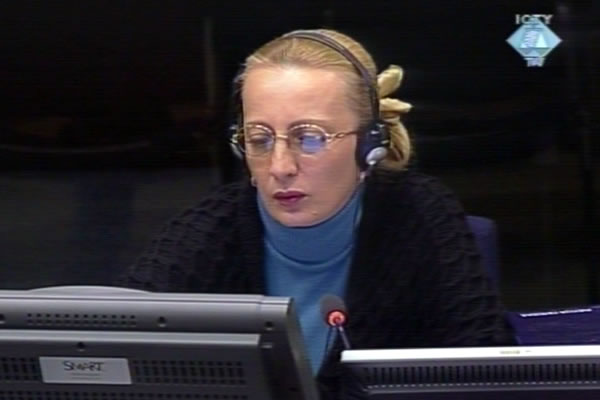Home
KARADZIC’S SECRETARY TESTIFIES
At the trial of Radovan Karadzic, the prosecution called his former secretary Mira Mihajlovic. Mihajlovic explained the meaning of minus and plus signs in the former Republika Srpska president’s log book
 Mira Mihajlovic, witness at the Radovan Karadzic trial
Mira Mihajlovic, witness at the Radovan Karadzic trial At the trial of former Republika Srpska president Radovan Karadzic, his former secretary Mira Mihajlovic was called to give evidence today. In 1994 and 1995, Mihajlovic was in charge of the archive of Karadzic’s office, located in the Famos building on Pale. Mihajlovic’s written statement and the log book in which all the visits to the Republika Srpska president’s office were registered was admitted into evidence.
In a brief examination-in chief, the witness used some documents to illustrate how documents were sent and received and how entries were made in the log book in the RS president’s office. As Mihajlovic said, Karadzic held meetings ‘behind closed doors’. The witness explained that she added the plus and minus signs next to the people’s names in the log book to indicate whether the planned meetings with Karadzic were actually held. Mihajlovic also kept record of how long the meetings lasted.
The log book shows that on 14 July 1995, immediately after the fall of Srebrenica, Karadzic met his civil affairs commissioner in Srebrenica Miroslav Deronjic in his office in Pale. Karadzic spent about six hours with Deronjic and other members of the delegation from Srebrenica.
In the cross-examination, Karadzic argued that even if a person did spend that many hours in his office, this didn’t mean that Karadzic spent the entire time talking to them. The witness confirmed that Karadzic would have several persons or delegations in his office at the same time and ‘would move from one to another’. Karadzic was happy to receive guests, particularly those from the Serbian émigré community, and if someone wanted to ‘take a photo with him’, Karadzic obliged.
With the help of his former secretary, Karadzic highlighted the purported ‘differences’ between the two types of documents in the possession of the prosecution that bear Karadzic’s signature: those actually originating from his office and those that were drafted ‘elsewhere’. Karadzic maintained that the infamous Directives Six and Seven had been drafted ‘elsewhere’.
Karadzic put it to the witness that a person unknown wrote Directive Six and then dropped by his office for it to be signed. The witness confirmed that the documents had a different heading and reference number than usual, and there was a dot after the abbreviation “Dr” in Karadzic’s signature block, which was not proper punctuation. The witness also noted that the document was written in the Latin alphabet. This, the witness said, meant that ‘no way had the document been drafted in the President’s Office’.
The witness spoke about the infamous Directive Seven which contains instructions to create ‘unbearable conditions of total insecurity’ for the people of Srebrenica and Zepa. As Mihajlovic explained, not only were the heading and the reference number different in this Directive, but Karadzic’s function was stated as ‘supreme commander’ instead of ‘RS president’ and it bore the seal of the VRS Main Staff, instead of the President’s Office.
In response to a question asked by presiding judge Kwon, the witness said that she could confirm ‘with certainty’ that both documents bore Karadzic’s signature.
Karadzic also noted that several months after he stopped coming to his office, in August 1998, some men from Ljubisa Savic Mauzer’s group broke into the president’s office in search for the information that could shed light on the murder of Srdjan Knezevic. The witness confirmed that the incident did occur. Mihajlovic said that when she returned to her office a month after the incident, she saw that the archive was empty.
Since the witness also confirmed Karadzic’s claim that the OTP investigators had at their disposal the entire archive from his office, in the re-examination the prosecutor brought up a document SFOR had seized in one of its raids. In his note of 5 February 1998, Milos Vukasinovic wrote to Karadzic that he was sending him a copy of a document found in the archives, saying that this single document, if found by the OTP investigators, could ‘contradict and render worthless’ all the documents used in Karadzic’s defense. In the letter, Vukasinovic advised Karadzic to destroy the document as soon as he received it, reassuring him that all the documents had been ‘reviewed and altered’.
When the letter was read to Karadzic’s secretary, she said, ‘I wouldn’t feel comfortable saying things I don’t know’, as regards the OTP investigators’ access to Karadzic’s archive. As for her opinion of Karadzic as a superior, president and human being, Mihajlovic thought he was the best.
Linked Reports
- Case : Karadzic
- 2012-02-07 LOGISTICS OFFICER FROM 10TH SABOTAGE DETACHMENT TESTIFIES AT KARADZIC TRIAL
- 2012-02-02 KARADZIC COUNTS PRISONERS ON AERIAL PHOTOS
- 2012-02-01 RUEZ: ONLY ‘VICTIMS OF EXTERMINATION’ WERE BURIED IN MASS GRAVES
- 2012-02-09 PASSING THE BUCK
- 2012-02-10 HOW DERONJIC SAVED THE HONOR OF BRATUNAC
- 2012-02-13 MOMIR NIKOLIC: HOW ‘EVIL’ IN SREBRENICA WAS PREPARED
